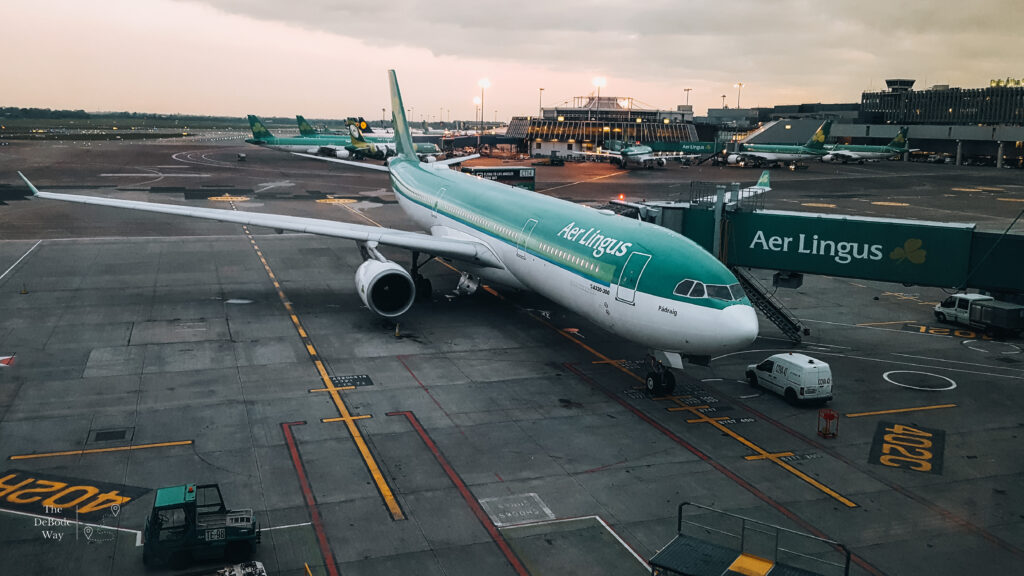We like to travel, and if you’re reading this blog, odds are you like to travel, too. Or maybe you like reading about travel? Either way, you’re among friends. Unfortunately, travel is, for most of us, expensive, and if the recent trends in inflation are any sign, those trip prices aren’t going down anytime soon. This is where your points and miles strategy comes into play.

In prior posts, we’ve talked about different things we do to try to keep some of those costs down, like traveling with carry-on luggage only as often as possible. One of the other ways we’ve managed to keep our costs down is through the responsible use of travel-focused credit cards; we’ve also talked about these in a handful of other blog posts. And while there are plenty of travel-related benefits that come with those cards (e.g., airport lounge access, waived baggage fees, point multipliers, hotel & airline credits, etc.), the most lucrative is one we have yet to discuss, so let’s remedy that now.
As we’ve mentioned before, the main reason we use travel credit cards is because they accrue points (e.g., our Chase Sapphire Preferred card) or miles (e.g., United Club Infinite Card), both of which can later be exchanged for actual travel benefits.

Free Stays with Hilton
For example, our Hilton Honors American Express Surpass card rapidly accrues Hilton Honors points every time it’s swiped or tapped (12X the points of any other card at Hilton hotels) and we use those points for free hotel stays, which is exactly what we’re doing to head to an all-inclusive resort in Mexico next month. To build upon this, we are ALSO part of the Hilton Honors loyalty program (you should be, too; it’s free) which keeps track of the number of nights you stay with Hilton and rewards you for your loyalty (right now we’ve managed to maintain our Diamond status for the past 3 years and yes, it’s as fancy as it sounds). Status can net you some pretty snazzy perks, like free room upgrades, free breakfasts & drinks, and access to more private parts of the hotel. Our Hilton Surpass card automatically awards you Gold status with the loyalty program without having to accrue all those nights on your own, giving you a helpful boost toward earning that top Diamond status. However, we originally earned Diamond the hard way by accruing nights in the loyalty program, during a pandemic that still had us on the road for work. Don’t be us. Get the card and use the perks.
Free Flights with United
Similarly, our United Club Infinite Card earns, as you might guess, United Airlines frequent flier miles. As with our Hilton card, the miles we earn with the United card earn us both status (which can get complimentary upgrades for you and others in your party, among other perks) and free flights. Every time we use that card to book a United flight, we earn 4X the miles with United than we would with another card. Miles = free flights. We like free flights. This obviously requires loyalty to a certain airline to work in your favor. Lucky for us, United is usually a great lower-priced option from Springfield with a quick layover in Chicago on our way to Europe, Denver on our way West, or Houston/Dallas on our way to Mexico.
So, the benefits that come with these cards are pretty great, even if there are annual fees you have to cough up to have them, most of which range from $95 – $700 each year (but it’s really not that bad; see a prior post about how we offset the annual fee for our United card). But how do we actually accrue those points? Well, there are two main ways.

Gas = Free Hotel Stays
First, we pay attention to how we can maximize our point accruals with our regular spending. Let’s say we’re on the road a lot and so spend more than our fair share on gas (story of our life). If that’s the case, then we’d look at the point multipliers for our different credit cards, see which has the highest multiplier for gas stations, and use that card for gas. Currently, for us, that’s our Hilton card at 6X the points at gas stations, aka Hilton points. Gas = free hotel stays. Often those multipliers on various cards can be 3-10x your purchase. So, if you spend $50 on gas, you can sometimes earn 150 – 500 points (but check your specific card’s terms to be sure). If you buy $50 worth of gas each week, every week of the year, that adds up to 7,800 – 26,000 points, and that’s just for your gas and probably just for one car (friendly heads up, if you get gas at a station affiliated with another kind of store (e.g., Wal-Mart), the gas charge isn’t always categorized as gas, but might instead show up as coming from that store, in which case you don’t get the multiplier – do your research before you choose where to fill).
We take a similar approach with most of our usual monthly bills so we can maximize the points we earn on each of our different cards. Importantly, this is our regular spending; we’re not buying new TVs every other day just to get the points, as that would be reckless, and are we reckless? Definitely not.
Still, through careful diligence and planning, earning points the normal way can take a good bit of time to accrue enough for a free vacation. Fortunately, there’s a way to supercharge your point accruals: the sign-up bonus. Let’s explain.

The Sign-Up Bonus
Most of the cards that carry an annual fee have what’s known in the business as a sign-up bonus (SUB). Each card has its own requirements for this, but the general process is that you need to spend a certain amount of money on that card (usually $3,000 – $5,000) in a certain amount of time (usually the first 3-6 months you have the card) to be rewarded with a huge chunk of points. You’d be surprised, as most of these are completely doable. For example, let’s take our first and favorite card: the Chase Sapphire Preferred. This card has an annual fee of $95 and is commonly considered among the best travel-focused credit card for most people. It has tons of great benefits, many of which we use all the time. Right now, this card has a SUB of 60,000 Chase points, which is great because Chase (like AMEX) points are super flexible because they can be transferred to Chase’s partners (like airlines, in which case they become frequent flier miles) or you can use them in Chase’s travel portal (which gives you a discount when paying with your points). To earn that SUB, you need to spend $4,000 in the first 3 months of having the card. That calculates to just over $1,300 for each of the first three months you have the card. If you’re currently spending more than this each month on another card, you can shift that spending to this card, if only temporarily, to earn the SUB and then change back. And remember: this is your usual spending, not anything new.
Similarly, the current SUB on our Hilton Honors American Express Surpass card ($95 annual fee) is 130,000 Hilton Honors points. To earn this, you need to spend $2,000 on the card in the first 3 months you have it; that’s less than $1,000 per month. And, just for another example, the current SUB on our United Club Infinite card ($525 annual fee) is 100,000 United Club miles after you spend $5,000 on the card in the first 3 months you have it. These are all enough points for multiple flights or hotel stays when planned carefully.

Have a Strategy
Just to tie this all together, let’s suppose you applied for and were approved for all three of the above cards in the space of a year (there are reasons why you’d want to space this out; we’ll talk about this in a different post). As a reminder, here are the details for the SUBs:
- Chase Sapphire Preferred: 60,000 Chase points after $4,000 in 3 months.
- Hilton Honors American Express Surpass: 130,000 Hilton Honors points after $2,000 in 3 months
- United Club Infinite: 100,000 United miles after $5,000 in 3 months
In total, you’d need to spend $11,000 on the three cards to earn the above SUBs. Okay, first yes, that’s a big chunk of change. But again, if this is over a year, that’s less than $1,000 per month. This is how we’re able to fit these cards into our regular spending, as we spend well over $1,000 each month on our cards.
But the points are in three different places, how is that helpful? You might ask. Well, that’s only kinda correct. The nice thing about Chase, or one of the nice things, is they have a ton of transfer partners. One of those transfer partners is United Airlines (sadly, not Hilton hotels). So, you can move those 60,000 Chase points to your United account and now you have 160,000 miles to cash in on your next trip (note that these transfers are one-way; you can’t transfer United miles to Chase and convert them into points). You also have 130,000 Hilton Honors points, which means you’re likely flying United to get where you want to go and will stay at one of the many Hilton properties across the world. Oh, and as an added bonus you can book a regular room with Hilton and because this card also gives you Gold status, you get complimentary room upgrades, space permitting. 😊

Reminders
So, by using certain cards with your regular spending, you’ve earned a free or heavily discounted vacation. Not too shabby, right? Right. Now for a few reminders:
- The above cards do have annual fees. If you got all three of these cards, you’d spend $715 in annual fees alone. That’s not nothing, but again, if you can divert your regular spending to these cards and it results in a free vacation, you can consider that vacation as having cost you $715. That’s still not too bad. Oh, and that’s assuming you don’t use any of the other benefits from those cards, which would be silly. Those benefits pay for the cards. Again, it’s important to have a strategy here.
- As we’ve said repeatedly in this post, and this is important so worth saying again: we advocate for the responsible use of these cards. As we said above, we’re not reckless. Spending beyond your means is a great way to get both yourself and your credit score (which you’ll need to get these cards) in trouble, and that’s a loss regardless of how nice the vacation is. We’ve found ways to leverage these cards and their benefits in our regular spending, so they don’t cause problems for us. They are paid off every month and we never pay interest. We’d encourage you to do the same, even if it takes a little longer to get that vacation.
- As with many things, when you move from one to multiple cards, things can get complicated (hello, spreadsheets!). There are behind-the-scenes rules that can make getting more cards more challenging, and sometimes impossible (we’ll talk about these in a different post soon). So, if that’s your plan, make sure you start with the card with the highest benefit for you.
Not sure where to start? Fortunately, our friends over at 10x Travel have done most of the hard work for you and have been a tremendous help to us over the years, so make sure you check out their website. We’re always happy to answer questions, too.
Happy traveling!





1 Comment
[…] you’re an avid reader of The DeBode Way (you are, right? Of course you are!) you’ll know that in our last post we talked about ways to maximize your travel points by earning Sign Up Bonuses (SUBs) from […]
Comments are closed.